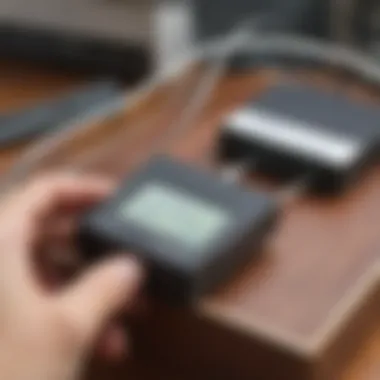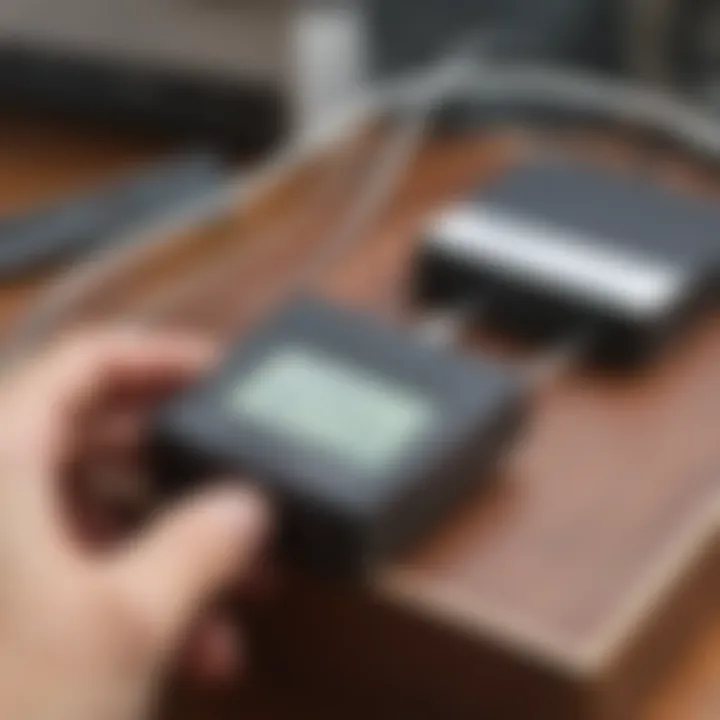Exploring Humidity Measurement Devices for Kids


Intro
Humidity measurement devices play a crucial role in helping us understand the moisture content in the air around us. For young explorers, or budding scientists, learning about how these devices function not only can broaden their horizons but also spark interest in scientific exploration. From the simple hygrometer to more advanced electronic sensors, each device has a unique way of measuring humidity. This guide aims to demystify these instruments and equip young learners with the knowledge and curiosity they need in their environmental adventures.
Preamble to Humidity
Humidity is an often overlooked yet crucial component of our environment. It refers to the amount of moisture present in the air around us. Understanding humidity is vital because it affects various aspects of our daily lives, from the comfort level in our homes to the health of plants in our gardens.
When young explorers dive into the concept of humidity, they begin to grasp why it's important to measure it. Measurement leads to knowledge, and knowledge can lead to discoveries. Imagine a day when the air becomes so thick and sticky that it's hard to breathe – that's high humidity in action! On the flip side, when the air feels dry, like in the winter months, it can cause skin and respiratory issues.
Humidity measurement provides a way to keep track of how ‘wet’ or ‘dry’ the air is, which can help prevent problems in different settings. For instance, farmers need to know humidity levels to ensure a healthy crop yield, while homeowners might want to measure it to maintain comfort indoors. By measuring humidity, young inquisitors can take the first step toward understanding weather patterns and making informed decisions.
"Knowledge of humidity helps us adapt our behaviors, stay healthy, and even support the environment."
In this article, we’ll open up the fascinating world of humidity measurement devices. We’ll explore what humidity is, why we measure it, and how that knowledge influences our environment. We will also see the different types of devices available, understanding their various functions. By engaging with this topic, young learners will not just be explorers; they will become informed citizens ready to tackle the daily challenges posed by the ever-changing atmosphere.
Types of Humidity Measurement Devices
Understanding the different types of humidity measurement devices is essential for anyone keen on exploring the concept of humidity. Each kind of device comes with its unique features, benefits, and applications. Knowing which device to use and when can make all the difference in accurately measuring humidity levels. In this section, we will dive deeper into the various types of devices available, exploring how they work, their benefits, and real-world applications.
Hygrometers
Hygrometers are perhaps the most commonly encountered devices that measure humidity. They come in several forms, each suited for different environments and applications. Some hygrometers use basic mechanical principles, while others rely on advanced electronic sensors.
- Mechanical Hygrometers: These often utilize a hair or a spring that expands and contracts based on humidity changes. A dial indicates the humidity level, allowing anyone to read it with ease.
- Digital Hygrometers: These modern devices read humidity electronically. They’re often more accurate and provide instant readings, which is perfect when you need to know the exact humidity levels quickly.
Using a hygrometer is like having a window into the air around us—by observing the humidity, one can predict discomfort or even anticipate weather changes. When aligned with temperature readings, they can provide valuable insights, for instance when the air is too humid for comfort or perhaps even too dry for plants in a garden.
Psychrometers
Moving onto psychrometers, these devices are specially designed to measure both temperature and humidity based on the principle of evaporation. They typically come in a pair: a wet-bulb and a dry-bulb thermometer.
- Dry-Bulb Thermometer: This thermometer measures the air temperature.
- Wet-Bulb Thermometer: This one has a bulb wrapped in a wet cloth; as the water evaporates, it cools down, allowing the device to measure relative humidity.
Psychrometers are often seen in laboratories and are instrumental in meteorology. They're somewhat like a science experiment you might conduct at home to see how evaporation can change temperatures, making it easier to comprehend the relationship between water vapor and temperature.
Dew Point Meters
Dew point meters take a different approach—they focus specifically on measuring the temperature at which air becomes saturated with moisture, forming dew. This device can be crucial for understanding when it might rain or when fog might form.
Dew point measurements help not only in weather predictions but also have vital applications in industrial settings. For example, when constructing delicate electronics, knowing the dew point can be critical in preventing condensation that might damage components.


Electronic Humidity Sensors
Lastly, we have electronic humidity sensors, which represent the cutting edge of humidity measurement technology. These devices utilize advanced sensors that can quickly provide precise humidity readings. Many of them can connect to smartphones or smart home systems, offering real-time data.
- Applications: You can often find these devices in homes, weather stations, and even in refrigerators! They help ensure that food stays fresh and that indoor plants remain healthy by maintaining optimal moisture levels.
- Advantages: The accuracy and speed of readings from electronic sensors make them particularly valuable in both domestic and commercial settings.
"Understanding the nuances of different humidity measuring devices can foster deeper appreciation for weather dynamics and their effects on our daily lives."
In summary, choosing the right humidity measurement device can impact accuracy, application, and relevance. Whether you opt for a hygrometer, psychrometer, dew point meter, or an electronic sensor, the goal is to connect more with the environment and understand the air we breathe. Each device serves its purpose in helping us observe and respond to the world around us better.
How Do Humidity Measurement Devices Work?
When diving into the world of humidity measurement devices, understanding how these tools operate is crucial. Just as a good chef needs to know the right temperature for the perfect soufflé, we too must grasp the science behind measuring humidity to appreciate its role in our daily lives. Humidity measurement devices, ranging from simple hygrometers to advanced electronic sensors, work based on scientific principles that help us collect accurate data about the moisture in the air. This understanding not only aids young explorers in grasping the fundamentals of atmospheric science, but also enhances their appreciation for the natural world.
The Science of Measurement
At the heart of humidity measurement is the idea of capturing and quantifying water vapor in the air. Water vapor is the invisible gas formed when water evaporates. Various devices measure humidity in different ways, often relying on physical principles like condensation, electrical resistance, or temperature differences.
- For instance, a hygrometer typically uses materials that change their properties in response to humidity: for instance, a strip of hair that expands and contracts based on moisture levels.
- A psychrometer, which contains two thermometers—one covered in a wet cloth—measures the difference in temperature between the two to calculate humidity levels through evaporation cooling.
Understanding these mechanisms can be an eye-opener for young minds, showing them the delicate interplay between water and air, which is vital for everything from weather patterns to the health of plants.
"Knowing how humidity measurement devices work elevates our awareness of weather phenomena and invites curiosity about the world around us."
Calibration and Accuracy
Calibration is like giving a tune-up to a musical instrument; it makes sure everything's in harmony. Humidity devices can lose accuracy over time, especially if they’re used in fluctuating conditions. This is where calibration comes in handy. Just like we check that our watches or scales are precise, humidity devices need the same care to ensure their readings are trustworthy.
To maintain accuracy:
- Routine Calibrations: Humidity devices should be calibrated at regular intervals, sometimes even daily or weekly, depending on usage.
- Reference Materials: Using known humidity levels as a benchmark can help verify if the device is functioning correctly. For example, placing a hygrometer in a controlled environment with a known level of humidity will show if its readings match the expected results.
- Avoiding Extremes: Devices should be stored in places where they’re not exposed to extreme temperatures or humidity fluctuations, as these conditions can throw off their accuracy.
In learning about calibration, young explorers are not just gaining practical skills to use these devices effectively, but they’re also developing a critical mindset about verifying information in all aspects of life.
Choosing the Right Humidity Measurement Device
Selecting the right humidity measurement device is like picking the right tool from a toolbox. It is essential as different devices suit different needs, depending on where and how they're going to be used. Understanding these options not only helps in achieving accurate readings but can also assist young explorers in learning the importance of their environment. Imagine if you were a scientist trying to figure out whether your plants need more water based on humidity levels. The right tool will lead you to the right conclusion!
Factors to Consider
When choosing the right humidity device, a few specific factors come into play. In the world of humidity measurement, these points will help make the best decision.
- Accuracy: This is crucial. A device that doesn't give precise readings can lead to confusion. Just like a compass pointing the wrong way can lead you in circles, inaccurate humidity readings might misguide you.
- Range: Some devices are better for high humidity levels, while others work fine for dry environments. Think about where you want to measure humidity. If it's in a damp basement, you would need a different device compared to measuring the air in a hotel lobby.
- Ease of Use: For children, it's important that devices are user-friendly. Complicated devices might just cause frustration.
- Price: Not every family can afford high-end gadgets. Sometimes, a basic device can perform just as well for home experiments.


Common Applications
Understanding where and how to use these devices can make all the difference. Let's explore how humidity measurement can be applied in daily life, specifically in various settings :
Home
At home, choosing a humidity measurement device can greatly benefit family well-being. A hygrometer can help monitor humidity levels in rooms like the bathroom or kitchen where humidity is often higher. This can prevent mold growth and ensure everyone's safety. Having a device in the living room where the family gathers can also add comfort by ensuring the air is not too dry or too humid. The big advantage of using a device in the home is how easily it can keep track of indoor comfort levels.
Laboratories
In laboratories, precision is the name of the game. Environmental scientists and researchers often employ sophisticated hygrometers and other devices to collect data. The key characteristic here is accuracy; scientists require reliable readings to conduct experiments that lead to precise conclusions. The unique feature of laboratory instruments is their ability to provide not just humidity but also other parameters like temperature. While these tools can be on the expensive side, their accuracy and reliability make them incredibly beneficial for scientific studies.
Industries
Lastly, in industrial settings, humidity control is crucial, especially in places like food packaging or textile manufacturing. High humidity can spoil food products or distort materials, leading to defects. Devices used here often come equipped with alarms and automatic adjustment features. The main benefit is continuous monitoring which helps avoid costly mistakes. However, the trade-off is the complexity often required to maintain these devices in a working environment.
By understanding the specific needs of each environment, you can select the perfect humidity measurement device!
Humidity and Its Effects on Our Environment
Understanding how humidity interacts with our surroundings is crucial for young explorers. Humidity doesn't just float around in the air; it has real impacts that can affect health, weather, and even the environment. By delving into the importance of humidity and how it shapes our daily lives, children can learn valuable lessons about the world around them.
Impact on Health
The way we feel in a room often depends on the humidity level. Too much moisture can make the air feel heavy and sticky, like wearing a wool sweater in the middle of summer. This uncomfortable feeling can sometimes lead to issues like heat exhaustion if it gets too extreme. Conversely, low humidity can make us feel dry and scratchy, contributing to chapped lips and dry skin.
Here are some key effects of humidity on our health:
- Breathing: High humidity can lead to increased allergens, which can trigger asthma or other respiratory issues. For some, too much dampness can make breathing harder.
- Comfort Levels: Moderate humidity is key. A good level helps keep us comfortable but too much can lead to sweating, while too little might make us feel cold and shivery.
- Microorganisms: Humid environments encourage mold growth. Mold can impact indoor air quality and trigger allergies.
"Keeping an eye on humidity helps us stay comfy and healthy in our homes and schools."
By learning about these effects, young people can make smarter choices about their living and learning spaces.
Influence on Weather Patterns
Humidity plays a pivotal role in the earth's weather. When the atmosphere holds many water molecules, it can create various weather phenomena. Think of how clouds form on a humid day, or the sudden downpours often seen in the summer.
- Cloud Formation: Humidity contributes to the process of cloud creation. When warm air rises, it cools and condenses, forming clouds. More humidity means more potential for clouds to grow, leading to rains and storms.
- Precipitation: High humidity conditions can cause heavy rainfall. Understanding this helps kids appreciate why some regions are rainy while others are dry.
- Temperature Fluctuations: Humidity can also affect temperatures. For instance, a humid day feels warmer than a dry one because moisture in the air prevents perspiration from evaporating efficiently.
So, next time the sky looks cloudy, remember that humidity is weaving its magic, shaping weather patterns and affecting our atmosphere. Recognizing these connections may inspire youngsters to take a deeper look at how climate and weather impact their world.
By focusing on the effects of humidity, we can help nurture a sense of responsibility towards the environment in our future generations.


Fun Experiments with Humidity Measurement
Exploring the world of humidity measurement through fun experiments can spark an eternal flame of curiosity in young minds. The hands-on approach of conducting experiments makes learning about humidity both engaging and educational. By connecting theoretical knowledge to real-world applications, kids can witness firsthand how humidity affects their environments. These experiments also develop a sense of scientific inquiry, encouraging children to ask questions, make predictions, and draw conclusions based on their observations.
Simple Experiments for Kids
There are a number of simple yet captivating experiments that children can conduct at home with minimal materials. Let's take a look at a couple that are bound to tickle their curiosity and reinforce their understanding of humidity.
- Dew Formation Experiment
This experiment helps kids understand why dew appears in the morning. - Humidity Jar
This experiment helps youngsters see how humidity levels can change the environment.
- Materials Needed: A glass of cold water, a plate, and some ice cubes.
- Instructions: Place the plate upside down on top of the glass. Add ice cubes to the plate.
- Observation: After a while, kids can observe water droplets forming on the plate, demonstrating how colder surfaces can cause moisture in the air to condense, creating dew.
- Materials Needed: A jar with a lid, cotton balls, and a measuring cup of water.
- Instructions: Saturate the cotton balls with water and place them in the jar. Close the lid and wait a few hours.
- Observation: They can examine how the inside of the jar becomes foggy, showing how humidity affects the air quality inside the enclosed space.
These simple experiments not only illustrate fundamental concepts of humidity but also encourage kids to think scientifically. They can learn about variables and how changing one element might alter the results.
Using a Hygrometer at Home
A hygrometer is a fantastic tool for kids to track humidity levels in their daily environment. Using one at home can turn into an exciting project where children can observe and record data.
- Observation Activities: Children can take daily measurements with the hygrometer and note the humidity levels at different times, like mornings, afternoons, and evenings. This will help them understand how humidity varies throughout the day.
- Local Weather Insights: By correlating their findings with local weather forecasts, they can learn about humidity’s role in weather conditions.
- Building Models: Once comfortable, kids can explore different types of hygrometers, such as digital vs. analog, discussing their pros and cons. This may ignite discussions on why certain types of devices are used in varied environments, enhancing their understanding of technology and its applications.
"Knowledge is the foundation of curiosity; nurtured, it blossoms into exploration."
Through these hands-on activities, children will grasp not just the concept of humidity, but the inherent value of measurement devices. They’ll be inspired to keep exploring and, perhaps, become future scientists excited about the wonders of our ever-changing atmosphere.
Culmination: The Importance of Humidity Measurement
Understanding and measuring humidity is not just scientific jargon; it's crucial for our daily lives and the world around us. This conclusion wraps up our exploration by pointing to the significance of humidity measurement devices and how they impact various aspects of existence.
First, let's recap the key points discussed throughout this article to emphasize their relevance. Humidity affects everything from our health to the environment. A device that accurately measures humidity helps us maintain a comfortable living space, safeguards our health against allergens, and ensures the freshness of food. Furthermore, it plays a pivotal role in industries like agriculture and manufacturing. Understanding these devices equips us to make informed decisions that can lead to better living standards.
Recap of Key Points
- What is Humidity? Humidity is the amount of water vapor present in the air. Knowing this helps us understand our environment.
- Why Measure Humidity?
Measuring humidity is essential for health, comfort, and productivity. - Types of Devices:
We explored various humidity measurement devices like hygrometers, psychrometers, and electronic sensors, each serving unique purposes. - Working Mechanisms:
Understanding how these devices function enhances our respect for them and allows us to select the right device for our needs. - Impact on Environment:
Humidity influences health and weather patterns, making measurements a part of sustainable living and environmental stewardship.
Encouragement for Exploration
We may have covered a lot, but this is just the tip of the iceberg! The world of humidity measurement is vast and ever-growing. Young explorers are invited to dive deeper into this exciting field. Why not conduct some of the experiments we discussed? Building a simple hygrometer or keeping a humidity journal could reveal the wonders of atmospheric science in your backyard!
As you continue your journey of exploring humidity, think about questions like:
- How does changing humidity affect your mood?
- What role does humidity play in your favorite hobbies, like cooking or gardening?
- Can you identify patterns in humidity and weather forecasts?
This exploration can change your understanding of the world by bringing science into your everyday life. Keep learning, asking questions, and seek out the answers! It's a journey well worth taking.
"The measure of intelligence is the ability to change."
So, let curiosity be your compass as you venture into the tangible and fascinating effects of humidity in our lives! Visit Wikipedia for more resources on humidity measurement.







